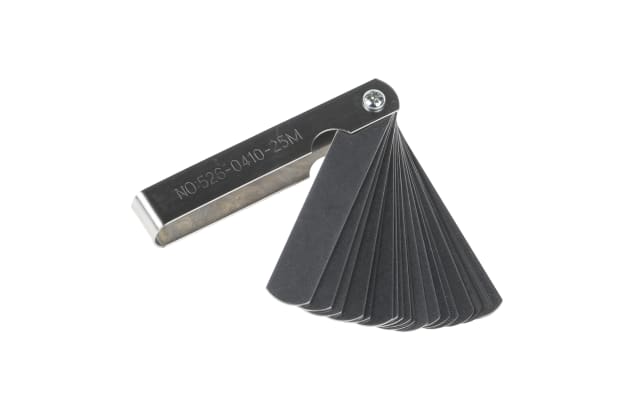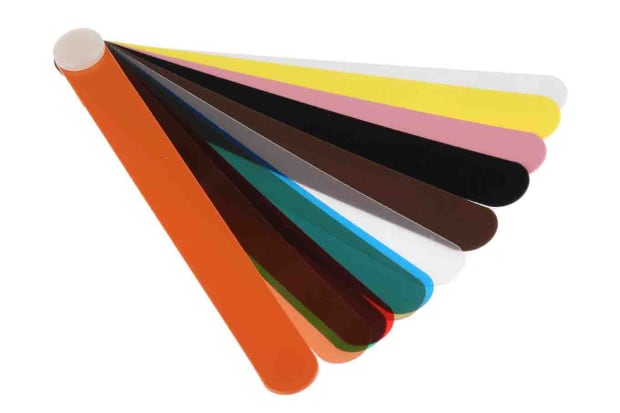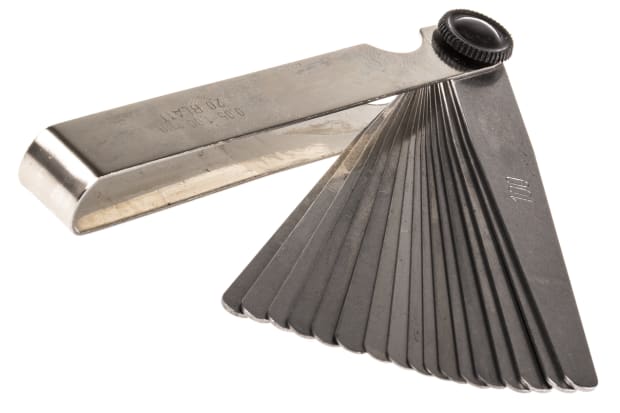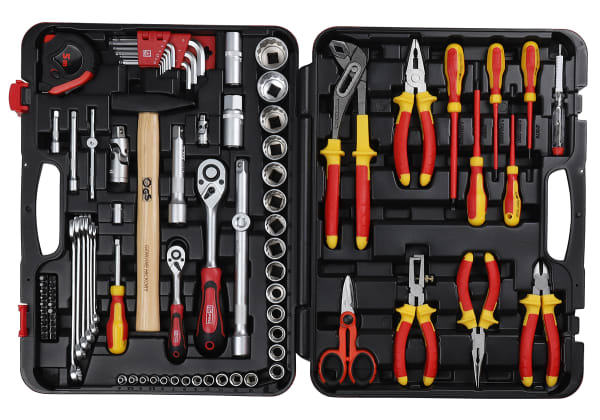- Published 17 Jan 2023
- Last Modified 29 Aug 2023
- 9 min
A Complete Guide to Feeler Gauges
Our feeler gauges guide explains their uses, the different types, how to use them, and which would be best for you.

This guide will explain in more detail what gap gauges are, their various uses, the different types available, and how to use them correctly. We will also try to help you decide which type of feeler gauge will best suit your needs and give concise answers to some frequently asked questions about these tools.
By the end of the guide, you should be familiar with what feeler gauges are and how to read them. You will also know about the various available sizes of metric and imperial models and be well informed when it comes to buying gap gauges online.
What is a Feeler Gauge?
A feeler gauge or a gap gauge is a tool - or, more commonly, a set of tools - used to check the width of small gaps between objects placed very close together. They are normally sold as a set of thin metal strips or blades, each graded for a different thickness.
It is usual to start by buying a full set of feeler gauges, as a single blade (also referred to as a leaf or shim) is not especially useful on its own. You normally use a feeler gauge by inserting strips of different thicknesses into a given gap and judging which gives the best fit to ascertain the approximate size of the opening.
What is a Feeler Gauge Used for?

A feeler gauge is a type of linear measurement tool. They are widely used by a variety of professionals, particularly in engineering and mechanical applications. They are especially common in automotive repair and maintenance tool bags.
Typical measurements you might want to check using a feeler gauge include tappet clearances, distributor points, spark plug gaps, bearing clearances, and piston ring gaps. You can also buy models suitable for a variety of other uses, such as a guitar feeler gauge.
Feeler Gauge Types
You can buy individual feeler gauges in the UK at specific thicknesses, which is a cheap and convenient way of replacing a single blade if one should snap or become damaged. However, it is usual to start with a full set of them.
Below, we have listed some of the most common types, materials and models of feeler gauges. Most are available either as full sets or as individual blades.
Wire Type Feeler Gauges
A wire-type feeler gauge is a little different to the standard shim arrangement. Instead of featuring a series of graded metal leaves or blades, the wire feeler gauge instead has a series of rigid metal wires.
Again, these are calibrated to specific thicknesses and normally bent over at a right angle. Wire type feeler gauges are typically used for measuring spark plug gaps, so you might also see them referred to as spark plug gap gauges.
Blade Feeler Gauges
A blade feeler gauge is probably the most common type of gap gauge you will encounter when shopping for these tools online. They usually feature a range of graded flattened metal shims or leaves which are designed to fold in or out of a central case or sheath.
The blades can typically be fanned out from the central case to easily select and access the one you want to use. If a single strip gets damaged or breaks, you can buy an individual one to replace it at the same thickness.
Thin Feeler Gauges
All feeler gauges are somewhat thin. This is because the point of them is to fit into and measure gaps that are far too narrow for most other common measuring tools, such as tape measures.
It is relatively rare to find sets that include blades any thicker than around 5mm at the upper limit, although they do exist. Most people who buy feeler gauges for mechanical or engineering work are more concerned with measuring much smaller gaps. In this regard, thin feeler gauges can be graded down to thicknesses of just 0.02mm or less.
The measurements for individual blades might be given in either metric or imperial units - or in both. When shopping online for gap gauges in the UK, remember to check that your chosen product displays the right type of measurement units for your requirements.
Angled Feeler Gauges
Angled feeler gauges are ones whose tips are bent over at a slight angle to the rest of the blade. This can be handy for accessing harder to reach gaps, where it may not be possible to slide a standard gap gauge in straight enough to get a good reading on the width of the opening. They are also known as offset feeler gauges.
Feeler Gauge Sets
It is more common to start by buying a feeler gauge set, and then later to replace any blades that become damaged or broken one at a time. A sheaf of multiple blades or leaves enables you to test various strips of different thicknesses in the gap you are trying to measure. This typically makes it fairly easy to work out the size of the gap by a simple process of comparison and elimination.

Plastic Feeler Gauges
A plastic feeler gauge is one whose blades are made from plastic instead of metal. While less physically robust than most metal equivalents, plastic feeler gauges can be very useful in certain scenarios and applications.
They do not corrode and are non-conductive and therefore non-sparking. They also will not scratch any of the parts you are trying to measure gaps between. Plastic versions will often be colour coded for easier differentiation between specific shim thicknesses.
How to Use a Feeler Gauge
When people ask, ‘what is a feeler gauge?’, they are often asking more specifically about how they are used. Understanding how to use a feeler gauge is fairly simple. There is a technique to it, but once you have got used to the feel of the tool in various gaps, it quickly becomes quite instinctive.
The most common way of using a feeler gauge is the so-called ‘Go, No Go’ technique. This involves trying out various thicknesses of blades in a gap, starting at the lower grades and working your way up.
At some point, you will reach a shim thickness that either will not go in, or that will go in but provides too much friction and resistance to slide back and forth easily. This is the ‘No Go’ point. The gap size is then determined to be equal to the last size of feeler gauge that slid back and forth in it reasonably well.
It is also easy to learn how to read a feeler gauge set. The exact placement of the measurements and sizing grades vary from brand to brand, but for the most part, you will find either metric or imperial measurements (sometimes both) etched somewhere on the blades themselves. Feeler gauge size charts are also sometimes included on the tool’s packaging, case, or storage pouch if it comes with one.

How to Use a Feeler Gauge on Spark Plugs
To check a spark plug gap with a feeler gauge, you need to insert a suitably sized blade between the ground electrode and the central electrode. You are usually looking for a gap of between 0.9-1.8 mm to meet general specifications, but these will vary somewhat from vehicle to vehicle.
It may be necessary to bend the ground electrode some way further from or closer to the centre electrode, using a spark plug gap tool, a standard pair of pliers or similar. You can then measure again using your spark plug feeler gauge to ensure the distance between the two is correct.
Feeler Gauge Sizes
Like most measuring and marking tools, feeler gauges are available in a wide range of sizes and thicknesses. They can range from as thin as 0.02mm or even less, typically up to around 5mm for the thickest blades in a set.
Some of the most common sizes you will likely find yourself using include 1mm, 1.5mm and 2mm feeler gauges. However, the ones you tend to use the most will of course depend largely on what type of work you are doing.
In terms of blade width (as opposed to thickness), there is not usually a great deal of variation from brand to brand. Most feeler gauge strips are around a half-inch wide.
You can buy shorter or longer versions, with short ones tending to measure about 75mm in length. Long feeler gauges are less common but still quite widely used for specialised applications, particularly in engine maintenance and repair. These models can be anywhere between 8 inches and 2 feet in length.
Metric and Imperial Feeler Gauges
Metric feeler gauges state the thickness of their individual blades in millimetres, while an imperial feeler gauge set will normally give measurements in hundredths or thousandths of an inch.
Imperial and metric feeler gauges that show both sets of measurement units are particularly common, and often preferred for professional applications. These will often separate the metric blades from the imperial blades at either end of the case or have the different measurement types printed on opposing sides of each strip.
What is the Best Feeler Gauge for You?
The best feeler gauge for a given application will depend mainly on the size of the gaps you are measuring, how durable you need the gauge to be, and what sorts of materials or parts you are measuring gaps between.
For working with very delicate or easily scratched materials, you may be better off with a plastic feeler gauge than a metal one. The same is also true if you are working in environments where a metal version might corrode, conduct electricity, or cause sparking.
However, for many standard engineering and mechanical applications, tempered or stainless steel is often the preferred material. Brass can also be a good option if you need something durable, but somewhat softer and less likely to scratch than steel.
In terms of blade thickness ranges, you should buy a feeler gauge that includes the full range of measurements you are likely to need. If you only need a few different sizes in your line of work, you may find it more cost-effective to buy a few individual feeler strips than a full set with a case. However, you will probably find yourself having to replace them just as often over time, meaning that a good quality feeler gauge set works out being just as economical in the long-run.

